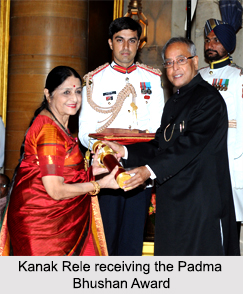 Kanak Rele is a popular Indian dancer and dance academician. She is a great exponent of Mohiniattam. She founded a dance academy named the Nalanda Dance Research Centre in Mumbai. She is a distinguished scholar of dance in present day India. For the last 35-40 years, she was tirelessly strived to take classical dance to larger audiences. The Mohiniattam dance form of Kerala has become almost synonymous to Kanak Rele. She is an accomplished lawyer with an LLB from the Government Law College, Mumbai and a diploma in international law from the University of Manchester. She also holds a Ph.D in dance from the University of Mumbai.
Kanak Rele is a popular Indian dancer and dance academician. She is a great exponent of Mohiniattam. She founded a dance academy named the Nalanda Dance Research Centre in Mumbai. She is a distinguished scholar of dance in present day India. For the last 35-40 years, she was tirelessly strived to take classical dance to larger audiences. The Mohiniattam dance form of Kerala has become almost synonymous to Kanak Rele. She is an accomplished lawyer with an LLB from the Government Law College, Mumbai and a diploma in international law from the University of Manchester. She also holds a Ph.D in dance from the University of Mumbai.
Early life of Kanak Rele
She was just seven years old when she started learning Kathakali. She was born in Gujarat. Dr. Rele spent a part of her childhood in Shantiniketan and in Kolkata with her uncle. At Shantiniketan, she had the chance to watch Kathakali and Mohiniattam performances which she states helped to shape her artistic sensibilities.
Career of Kanak Rele
Rele is a Kathakali performer having been trained under Guru "Panchali" Karunakara Panicker since the age of 7 years. During 1970 to 1971 she travelled to Kerala filming promoters of the dance form such as Kunjukutty Amma, Chinnammu Amma and Kalyanikutty Amma. Rele`s idea of body kinetics in dance is a pioneering improvement that disaggregates body movements in Mohiniattam using a notation system. Dr. Rele is credited with having played a key role in the revival and popularisation of Mohiniattam and for having brought a scientific displeasure and academic inflexibility to it.
Kanak Rele is a popular name in India and aboard as well. She performs regularly on foreign soil. She has travelled aboard both for private shows and as a representative of Government of India. In the recent past, however, Rele has scaled tremendous heights as both a scholar and performer. She teaches her students regarding the art of applicability to Mohiniattam.
Rele is also credited for introducing formal studies in dance. Rele"s productions trait strong female characters like Amba (based on Shikhandi), Gandhari or Draupadi. Rele founded the Nalanda Dance Research Centre in 1966 and the Nalanda Nritya Kala Mahavidyalay in 1972. Rele has also served as a specialist and advisor on dance to the Department of Culture of the Government of India and the Planning Commission and has been a part of the University Grants Commission`s programme development team and a professional to Indian and foreign universities in developing academic dance courses.
Notable performances of Kanak Rele
Some of her extraordinary subjects and choreographies consist of Kubja, Kalyani, Silappadikaram and Swapnavasavadattam. Rele has praised Kavalam`s compositions as being stirring for some of her choreographies. "Nritya Bharati", a documentary on India`s classical dances produced by her Nalanda school has been acquired by the Ministry of External Affairs as the official capsule for all Indian missions overseas. The Enlightened One - Gautama Buddha which premiered in 2011 was a choreographic piece produced against the conditions of the 26/11 attacks on Mumbai.
Awards of Kanak Rele
Following are the awards of Kanak Rele:
•Gaurav Puraskar
•Padma Shri
•Title of `Kala Vipanchee`
•Kalidas Samman
•Sangeet Natak Akademi Award
•M S Subbulakshmi Award
•Padma Bhushan



















